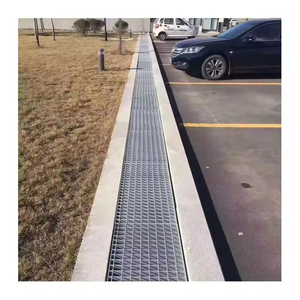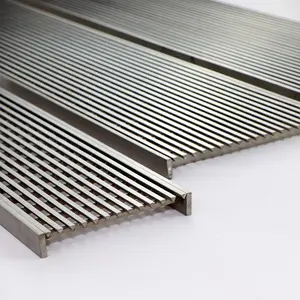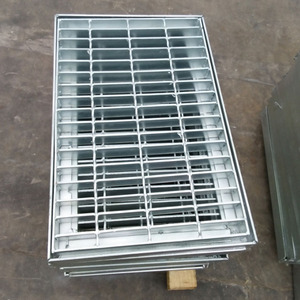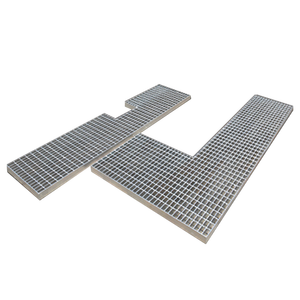(10489 products available)



































































































































































































A trench grate, also known as a channel cover, is a metal grate installed on open channels or drains to allow water to flow freely while providing safety and accessibility to pedestrians and vehicles. Trench grates for sale come in different types based on materials used, applications, and load ratings.
Based on material, the types of trench grates include:
Steel trench grates: These are the most popular type of trench grate due to their strength and durability. They come in galvanized and stainless steel options. Galvanized steel trench grates are affordable and popular for residential and commercial areas with low to medium traffic. On the other hand, stainless steel trench grates are more resistant to corrosion and are suitable for areas like parking lots, driveways, and pedestrian walkways. Stainless steel is often used in applications where aesthetic appeal is necessary.
Aluminum trench grates: Aluminum trench grates are lightweight and resistant to rust. They are ideal for applications where weight is a concern, such as in portable drainage systems. They are also popular in coastal areas where saltwater can cause corrosion. Aluminum trench grates are often used in public spaces due to their tendency to blend into surroundings.
Ductile iron and cast iron trench grates: These types of trench grates offer high corrosion resistance and are very durable. Cast iron trench grates offer different designs and are ideal for areas where aesthetics are important. Ductile iron trench grates are suitable for high-load applications like airports and factories. They are also used in heavy traffic areas like industrial facilities and streets.
Plastic and composite trench grates: These types of trench grates are lightweight and resistant to rust. They are ideal for residential applications and offer excellent drainage. They are also used in areas where weight is a concern and are available in different colors. Composite trench grates are made from recycled materials and are popular for pedestrian areas and residential applications.
Trench grates by application: Trench grates are applied in different industries and sectors. For instance, landscape trench grates are used in outdoor areas like parks and driveways, while architectural trench grates are used in residential and commercial settings. Other types of trench grates based on application include industrial trench grates, which are used in manufacturing and processing facilities. They are designed to handle heavy loads and harsh conditions. Traffic trench grates are installed in streets, roads, and highways. They are constructed to withstand the weight of vehicles and pedestrian traffic.
Trench grates by load rating: Trench grates are rated according to the load they can support. They include light-duty trench grates, which are ideal for areas with pedestrian traffic only. Medium-duty trench grates are suitable for areas with pedestrian and light vehicular traffic. They are popular in commercial settings. Heavy-duty trench grates are designed for high-load applications. They are constructed from strong materials and are suitable for areas with intense traffic.
Trench grates cover several features and functions that enhance drainage systems and contribute to safety and aesthetics. These features include:
Drainage
The primary function of trench grates is to provide drainage. The gaps between the bars allow water to flow into the trench, preventing flooding in areas with heavy rainfall or water runoff. They help control water flow and direct it to appropriate drainage points.
Safety
Trench covers enhance safety by ensuring pedestrians and vehicles are safe from falling into the drainage. They create a solid, stable surface that can support the weight of pedestrians and traffic above the trench. Trench grates for driveways are designed to withstand the pressure of vehicles.
Aesthetics
These trench covers come in various designs, materials, and finishes that enhance the visual appeal of outdoor spaces. They can be customized to complement the surrounding landscape or architecture. Their design contributes to the overall aesthetics of an environment.
Ventilation
Some trench grates are designed to enhance airflow. The gaps and spaces in the grate allow air circulation. Proper ventilation is essential in preventing the buildup of harmful gases in the drainage system. Airflow helps regulate temperature in the drainage.
Debris filtration
The layout of trench grates prevents large debris from entering the drainage system. The bars or slats trap leaves, twigs, and other debris, preventing clogs and ensuring smooth water flow. Some grates have mesh liners that prevent small debris from entering the trench.
Durability
The materials used to manufacture trench grates are durable. Materials like steel and cast iron are resistant to rust and corrosion. This ensures longevity and continuous drainage with minimal maintenance. They can withstand wear-out from pedestrian and traffic flow.
Customizability
Trench grates are customizable to meet specific needs. They come in various sizes, shapes, and materials. This ensures they fit different applications and environments. Their design can be adapted to fit unique architectural designs or landscape requirements.
Environmental sustainability
Some trench grates are manufactured with recycled materials. Their design promotes sustainable water management practices. Perforated trench drain grates allow water to infiltrate the ground, promoting groundwater recharge.
Trench grates are used in different industries. Some of the common scenarios include:
Choosing the right trench cover for a project requires careful consideration. Here are some factors that contractors should consider when choosing trench grates:
Material
Trench covers are constructed with different materials. Each material has its unique benefits. Steel is a durable material and offers different finishes. Galvanized steel is anti-corrosive and suitable for areas with high temperatures. Ductile iron has high load capacity and is suitable for heavy-duty applications. Aluminum is lightweight and easy to install. It is suitable for areas with low traffic. The material of the trench cover affects its durability, corrosion resistance, and load capacity. Contractors should consider the environmental factors before choosing the material.
Load capacity
One of the main reasons why trench drains are installed is to prevent flooding. The load capacity of the trench grate determines its effectiveness. The load capacity is classified into different categories. Each category indicates the suitability of the grate for different applications. Class A is suitable for pedestrians. It has a load capacity of up to 2.5kn/m. Class B is suitable for pedestrians and cyclists. It has a load capacity of up to 6.0kn/m. Class C is suitable for pedestrians, cyclists, and vehicles. It has a load capacity of 12.5kn/m. Class D are suitable for vehicles and cars. It has a load capacity of 20kn/m. Class E are suitable for heavy-duty applications. They have a load capacity of 30kn/m. Choosing a trench grate that can withstand the expected load is important to avoid collapse.
Slip resistance
The slip resistance of the trench cover determines the safety of the area. Slip resistance is measured using a coefficient. A higher slip resistance coefficient means the area is safer. The type of trench grate used in this case should have a high slip resistance coefficient. Areas with high foot traffic require trench grates with slip resistance features. This is to prevent accidents and ensure the safety of pedestrians.
Design and appearance
Trench grates come in different designs and finishes. This makes it possible for contractors to choose a trench grate that matches the aesthetics of the landscape. Some materials can be customized with logos or other patterns. Many trench grates can be locked in place and easily removed for maintenance.
Q1. Are trench grates load-bearing?
A1. Yes, some trench grates are load-bearing. They can support pedestrian traffic or vehicles, depending on the application.
Q2. What is the purpose of a trench grate?
A2. A trench grate covers a drainage channel, allows water to flow freely into the channel, and provides a safe walking surface.
Q3. What are the types of trench grates?
A3. The main types of trench grates are: Slip trench grate, Bolted trench grate, and welded trench grate.